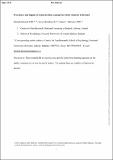Prevalence and impact of dysmenorrhea among University students in Ireland

View/
Date
2021-04-03Author
Durand, Hannah
Monahan, Katie
McGuire, Brian E.
Metadata
Show full item recordUsage
This item's downloads: 135 (view details)
Recommended Citation
Durand, Hannah, Monahan, Katie, & McGuire, Brian E. (2021). Prevalence and impact of dysmenorrhea among University students in Ireland. Pain Medicine. doi:10.1093/pm/pnab122
Published Version
Abstract
Abstract
Objective
Primary dysmenorrhea (PD), or painful menstruation, is a common gynaecological condition that can cause intense pain and functional disability in women of reproductive age. As a non-malignant condition, PD is relatively under-studied and poorly managed. The purpose of this study was to estimate the prevalence and impact of PD among third-level students in Ireland.
Design
Cross-sectional observational study.
Methods
Students (N = 892; age range = 18–45) completed an online survey on menstrual pain characteristics, pain management strategies, pain interference, and pain catastrophizing.
Results
The prevalence of PD was 91.5% (95% Confidence Interval = 89.67–93.33). Non-pharmacological management strategies were most popular (95.1%); of these, heat application (79%), rest (60.4%), hot shower/bath (40.9%), and exercise (25.7%) were most common. Perceived effectiveness of these methods varied between participants. Analgesic use was also common (79.5%); of these, paracetamol was most used (60.5%) despite limited perceived effectiveness. Pain catastrophizing was a significant predictor of variance in both pain intensity and pain interference scores such that those with higher pain catastrophizing scores reported more intense pain and greater interference with daily activities and academic demands.
Conclusions
This article presents the first investigation into PD among third-level students in Ireland. Poorly managed menstrual pain may impact functional ability across several domains. Future research should focus on improving menstrual pain management education and support, and promoting menstrual health literacy for women affected by PD.

